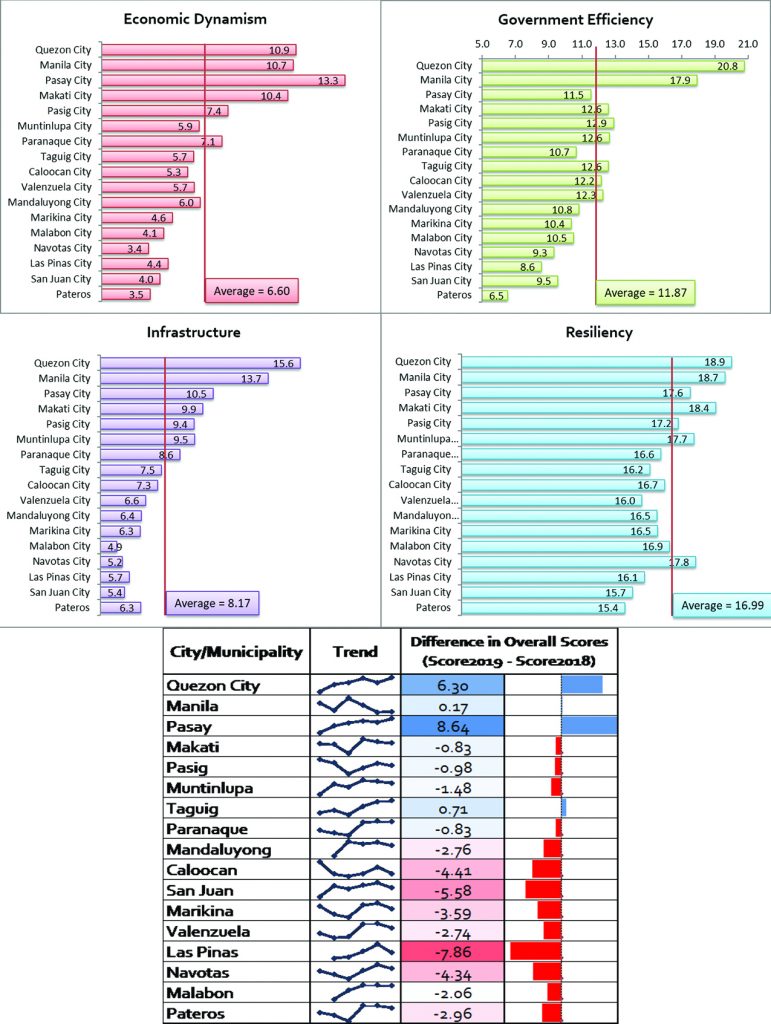 The University of the Philippines Institute for Small Scale Industries (UP ISSI) once again validated the National Capital Region (NCR) data for the Cities and Municipalities Competitiveness Index Project. As the academic partner of the Department of Trade and Industry-NCR Office, UP ISSI acted as the focal agency that collect and generate data for the local government units in NCR which consist of sixteen (16) cities and one (1) municipality. Consolidated data fall under the four competitiveness pillars of (1) Economic Dynamism, Efficiency, Infrastructure and Resiliency. Each pillar consists of ten (10) indicators further divided into sub-indicators. Overall, UP ISSI collected data for the 234 indicators and sub-indicators for the years 2011-2018. However, due to changes in the indicators, only indicators for the years 2015-2019 (were comparable and) were processed.
The University of the Philippines Institute for Small Scale Industries (UP ISSI) once again validated the National Capital Region (NCR) data for the Cities and Municipalities Competitiveness Index Project. As the academic partner of the Department of Trade and Industry-NCR Office, UP ISSI acted as the focal agency that collect and generate data for the local government units in NCR which consist of sixteen (16) cities and one (1) municipality. Consolidated data fall under the four competitiveness pillars of (1) Economic Dynamism, Efficiency, Infrastructure and Resiliency. Each pillar consists of ten (10) indicators further divided into sub-indicators. Overall, UP ISSI collected data for the 234 indicators and sub-indicators for the years 2011-2018. However, due to changes in the indicators, only indicators for the years 2015-2019 (were comparable and) were processed.
 Economic Dynamism
Economic Dynamism
The first pillar, Economic Dynamism, is associated with activities that create stable expansion of businesses and industries, and high employment. This is the concrete representation of productivity as it matches the output of the local economy with local resources.[1] Indicators under this pillar include: (1) Size of the local economy, (2) Growth of the local economy, (3) Structure of local economy, (4) Safety compliant of business, (5) Increase in employment, (6) Cost of living, (7) Cost of doing business, (8) Financial Deepening, (9) Productivity, and, (10) Presence of Business Professional Organizations.
Government Efficiency
Government efficiency refers to the quality and reliability of government services and government support for effective and sustainable productive expansion.[2] Indicators under this pillar include (1) Compliance to National Directives, (2) Presence of Investment Promotion Unit, (3) Business Registration Efficiency, (4) Capacity to Generate Local Resources, (5) Capacity of Health Services, (6) Capacity of Education Services, (7) Recognition of Performance, (8) Compliance to Business Permits and Licensing System (BPLS) Standards, (9) Peace and Order, and (10) Social Protection.
Infrastructure
Infrastructure includes the physical building blocks that connect, expand, and sustain a locality and its surroundings to enable the provision of goods and services.[3] Measures of infrastructure include (1) Roads, (2) Ports, (3) Basic Utilities, (4) Number of public transportation vehicles, (5)Education Infrastructure, (6) Health Infrastructure, (7) LGU Investment in Infrastructure, (8)Accommodation Capacity, (9) Information Technology Capacity, and, (10) Financial Technology Capacity.
 Resiliency
Resiliency
Resiliency measures how LGUs prepare their locations, environment, firms, and people to respond to different kinds of shocks to ensure sustainable growth. Resilience is equivalent to sustainability beyond natural and man-made disasters…. For LGUs to be sustainable, it is necessary that they are resilient to all types of vulnerabilities and risks, so that the people living and working there- particularly the poor and vulnerable- survive and thrive no matter what stresses or shocks they encounter.[4] Indicators for this pillar are (1) Land Use Plan, (2) Disaster Risk Reduction Plan, (3) Annual Disaster Drill, (4) Early Warning System, (5) Budget for Disaster Risk Reduction Management, (6) Local Risk Assessments, (7) Emergency Infrastructure, (8) [Redundancy of] Utilities, (9) Employed Population, and, (10) Sanitary System.
In the scoring, each pillar weighs 25%; and the indicators were each given a score of 2.5%. Historically, NCR cities always figure in the top competitiveness ranks. In the past four years, Quezon City was cited as Most Competitive City in the Country, bagging the Hall of Fame Award. In 2019, National Capital Region displayed a decrease in its average Competitiveness Index (43.64, -1.46 pts) compared with its score in the previous year. Four out of 16 cities score more than 50% (out of 100% perfect score). These cities are Quezon City, Manila, Pasay, and Makati.
Only four NCR LGUs exhibited increase in their overall scores. Pasay scored 8.64 percentage points higher than their score in 2018, followed by Quezon City with an increase of 6.3 percentage points. The Cities of Taguig and Manila showed minimal increases, while all other NCR LGUs demonstrated decreases in their overall competitiveness scores.
Quezon City, Pasay, and Malabon exhibited consistent increase in their Competitiveness Scores. All other LGUs in the region revealed erratic scores in the past five years.
The succeeding trendlines show how the other Highly Urbanized Cities in the country fared in the Cities and Municipalities Competitiveness Index in the last five years, covering the fiscal years 2015-2019.

____________________________
[1] This definition is taken verbatim from the 2018 Cities and Municipalities Competitiveness Index Operations
Manual, p. 6.
[2] Ibid., 9.
[3] Ibid., 12.
[4] 2018 Cities and Municipalities Competitiveness Index Operations Manual, p. 16.
Disclaimer: The views expressed herein or in any article in the UP ISSI website are those of the authors and do not necessarily reflect the policies or opinions of UP ISSI nor the views of the University of the Philippines. Regarding Accuracy of Information and Usage of Data: Visitors and users of the UP ISSI website are advised that information contained within the website is assumed to be accurate. However, errors can occur even with computer-generated information. UP ISSI makes no representation regarding the completeness, accuracy, or timeliness of such information and data, or that such information and data will be error-free. Visitors are encouraged to review the official version of all documents on which they plan to rely on.